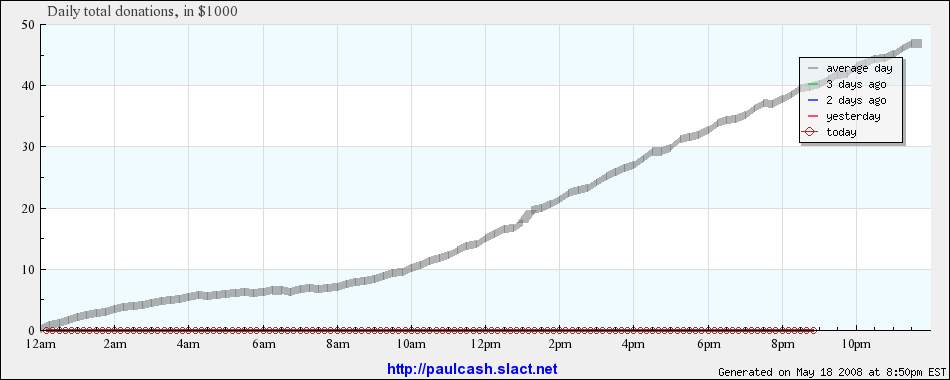I've tweaked the grapher to remove outliers -- numbers that are way inconsistent with the rest, such as the Nov 5th rates -- from the daily averages. I think this provides a much more useful view - the average line on the daily graph now represents "an average day" -- since November 5th was anything but average, and it could be misleading to compare the donation rates of a plain non-moneybomb day with the average of every day, moneybomb or not.
Let me know what you think.
Wednesday, November 14, 2007
Outliers
Posted by
Leo
at
12:52 PM
![]()
Labels: site updates
Subscribe to:
Post Comments (Atom)






8 comments:
The moneybomb day should be averaged out through the month. In the days leading up to the moneybomb, donations dropped very low, and I believe the same is happening even now, as regular donators are waiting for the big Dec 16 moneybomb to donate.
Neither including them or non including them is ideal. The first gives a misleadling sense of the current rate (even though many are anticipating a MAJOR Dec. 16th boost); but excluding them makes the situation seem more desperate. This, contrary to what some may think, is not good, since people seem more inclined to participate in ventures which are doing well. How about splitting them into an included/not included table so people can see both how the "daily" average looks as well as the "exceptional" daily average.
I appreciate this change, I think it provides more useful information about how each days donation rate compares to others.
One thing that makes determining best practice with your kind of charts is the uniqueness of the data. Obviously, with the FEC there is a lot of donation data available, but it isn't near real time. The real time combined with a relatively large and active supporter base creates a fairly unique feedback loop.
I do not think the "money bomb" concept would have happened without the feed and the meter.
I fully expect many attributes of this campaign (regardless of outcome) will be the subject of academic research.
Did you drop the highest value before calculating the average? Or, did you use some other method?
If you have time I would appreciate a little bit more detailed explanation.
Thanks.
Well, now the Q4 projection is $10.59M which seems to be WAYY off, so you need to do something to reflect the "money bombs".
Maybe you should use the ARMA model you had considered before as:
ARMA is appropriate when a system is a function of a series of unobserved shocks (the MA part) as well as its own behavior.
Just a thought.
Absolutely the right thing to exclude moneybombs.
The usefulness of the average predictions are to set expectations.
For a presidential campaign, expectations are everything. To blow them away brings the best possible result: people encouragement and press coverage.
Further, with lower expectations, other competitive campaigns are less likely to "step it up" as soon out of a sense of urgency.
"When your enemy thinks you are strong, act weak." Sun Tsu, The Art Of War
Brad:
While looking weak might seem like a good idea, it's a bad idea in politics to look like you can't win.
But heck, what do I know.
Now that the Nov. 30 minibomb is cleared out of the history in the graphs, a problem with the technique used to remove the bomb data presents itself. The average day's contributions line is no longer monotonically increasing. This defies sanity.
Post a Comment